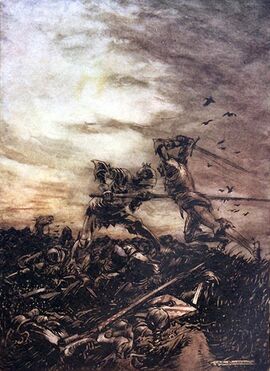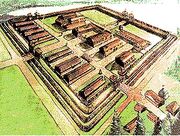
The Battle of Camlann (Welsh: Gwaith Camlan or Brwydr Camlan) is reputed to have been the final battle of King Arthur, in which he either died or was fatally wounded, fighting either with or against Mordred who is also said to have died.
Description[]
The English Stanzac Morte Arthur differs little from the Vulgate Mort Artu. Arthur's side and Mordred's rebels meet on the field to negotiate. An agreement is made according to Mordred shall rule Cornwall and Kent while King Arthur is alive, and be recognized as King Arthur’s heir to receive all of Britain, when King Arthur dies. But neither Arthur nor Mordred trusts the other, and before finalizing the treaty, both order their men to attack at once if they see a sword drawn. While Arthur and Mordred are negotiating the treaty, an adder in the grass stings one of Mordred’s knights. The knight, not thinking, whips out his sword to kill the adder, King Arthur’s men see the sword, and the battle begins.
Original Usage[]
Camlann as the site of Arthur’s final battle is first mentioned in the early 10th century Annales Cambriae. In this work, the Battle of Camlann is dated to the year 537. Historians are not entirely convinced with this entry in the Annales and have postulated that the monks may have inserted a final date to end Arthur’s reign. Some suspect a 'thrice seven' year period between Arthur’s greatest battle (Mount Badon) and his eventual death could have arisen from Welsh tradition. Thus, the monks may have listed the Camlann incident in the Annales 21 years after their listing of the Badon battle. However, even though the battle at Camlann may not be reliably dated, it is still considered that Camlann was the place where the legendary King Arthur fell. The monks mention Mordred (Medraut) but do not state that Arthur he fought on opposite sides.
Gueith camlann in qua Arthur et Medraut corruerunt.
(The Strife of Camlann in which Arthur and Medraut [Mordred] perished.)
Possible Site Locations[]

The Roman fort north of the Antonine Wall near Camelon in Scotland – just one of the possible sites for Camlann
Many later tales (e.g. Geoffrey of Monmouth’s Historia Regum Britanniae) expand on this battle and suggest locations for Camlann. Additionally, various authors have also put forward theories as to its whereabouts. These range from areas at or near: the River Cam in Somerset; the Roman fort of Camboglanna (Cam-lanna) on Hadrian’s Wall, now known as Castlesteads in Cumbria; the River Camel in Cornwall; the River Camlan in Gwynedd (NW Wales) and the Roman fort at Camelon (Scottish Gaelic = Camlan) in Falkirk, Scotland.
